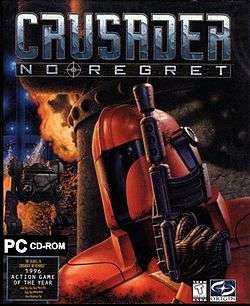Crusader: No Regret
| Crusader: No Regret | |
|---|---|
 | |
| Developer(s) | Origin Systems |
| Publisher(s) | Electronic Arts |
| Director(s) | Tony Zurovec |
| Producer(s) | Tony Zurovec |
| Designer(s) | Mark Vittek |
| Programmer(s) | Tony Zurovec |
| Composer(s) |
Dan Gardopée Todd Parsons Andrew Sega |
| Engine | Enhanced Ultima VIII: Pagan engine |
| Platform(s) | PC (DOS) |
| Release date(s) |
‹See Tfd› ‹See Tfd›
|
| Genre(s) | Action game |
| Mode(s) | Single-player |
Crusader: No Regret is an isometric action game developed by Origin Systems and published by Electronic Arts in 1996. Nominally a sequel to 1995's Crusader: No Remorse, it is considered both by critics and by the game director more akin to a stand-alone expansion pack.[2][3] Mechanically similar to No Remorse, it features new levels, enemies and weapons.
Set immediately after the events of No Remorse, No Regret chronicles the further adventures of the Silencer, a supersoldier-turned-resistance-fighter in a dystopian 22nd century.
Gameplay
The gameplay is similar to Crusader: No Remorse. The player controls the Silencer as he fights his way through the levels. Teleportation pads are used for quick travel within and between levels.
No Regret added several new weapons and death animations, including freezing (and subsequent shattering) and two different kinds of melting. In No Remorse, the Silencer could carry no more than five firearms at once; in No Regret, this restriction was lifted entirely. Nonplayer characters no longer carry money, since there are no friendly merchants to deal with on the Moon.
Gameplay is more combat-oriented than that of No Remorse. In that game, many obstacles could either be circumvented, defeated with items such as passkeys, or blown up with brute force. This latter tactic is usually the only available course of action in No Regret.
Plot
No Regret begins 46 hours after the events in No Remorse. A WEC freighter headed for the Moon picks up the escape pod, and the Silencer, upon moonfall, makes contact with the local Resistance. The WEC uses the moon as both a mine and prison, where most of the political dissidents and Resistance members are forced to extract a precious radioactive compound, Di-Corellium, the mineral that is the basis of virtually all energy production on Earth. Approximately half of all known reserves are on the Moon, and a shortage of Di-Corellium would cause serious problems for the WEC. For this reason, Chairman Draygan is on the Moon to oversee the Di-Corellium production, which has been lagging recently—possibly due to incursions from the Resistance cell on Moon, at the hidden Dark Side base. On learning of the Silencer's presence, he sics all his forces against him.
Over the course of No Regret's ten missions, the Silencer works to undermine the WEC presence on the Moon, culminating in a showdown with Chairman Draygan who pilots a mech. The WEC's lunar headquarters are destroyed and the Resistance takes control of mining operations, with the hint of further conflicts with the WEC. The game's story is notably more simplified and straightforward than that of No Remorse.
Development
Both games use an advanced version of the Ultima VIII: Pagan isometric view engine featuring full SVGA graphics. The game's audio uses a specially made engine, called Asylum Sound System, which employs MOD files rather than General MIDI, in order to provide good quality without relying on expensive hardware. Each mission and intermission level has its own track. The soundtracks for both games were composed by Andrew Sega and Dan Grandpre of the now-defunct Straylight Productions.
The Crusader games feature full motion video (FMV) sequences with live actors; FMVs are used in cutscenes to further the story, generally through interaction with other characters. These conversations are generally one-sided, as the player character never speaks. Like many Origin games, both No Remorse and No Regret shipped with significant in-universe back-story material, including a fold-out propaganda poster, newspaper and guides from the WEC and the Resistance.
A working title of Crusader: No Regret was No Quarter and Origin management also wanted to release it as Crusader II: No Regret. A cancelled multiplayer expansion was to be titled Crusader: No Survivors.[4]
Reception
| Reception | ||||||||||||||||||
|---|---|---|---|---|---|---|---|---|---|---|---|---|---|---|---|---|---|---|
| ||||||||||||||||||
Re-release
No Remorse and No Regret were re-released with compatibility for Windows XP/7/8 and Mac OS X (10.8.6 or newer) on GOG.com.[10]
References
- ↑ https://www.origin.com/en-us/store/buy/crusader-no-regret/pc-download/base-game/standard-edition
- ↑ Cobbett, Richard (2011-11-30). "Reinstall: Crusader:No Remorse". PC Gamer. Retrieved 2016-07-05.
- ↑ "News - Your questions about Crusader answered by Tony Zurovec". GOG.com. Archived from the original on 2014-08-16. Retrieved 2012-10-13.
- ↑ ""We had a lot of fun with the other explosives…" – An Interview with Jason Ely". ultimacodex.com. 2014-03-18. Retrieved 2014-05-16.
UC: Were there more Crusader games planned, provided Origin hadn’t closed down? JE: There were actually two more Crusader games planned — Crusader: No Mercy and Crusader: No Survivors.
- ↑ "Crusader: No Regret for PC". GameRankings. 1996-09-10. Retrieved 2012-10-13.
- ↑ September 12, 1996 12:00AM PDT (1996-09-10). "Crusader: No Regret Review". GameSpot.com. Retrieved 2012-10-13.
- ↑ PC Gamer | Crusader: No Regret
- ↑ PC Gamer Online | Crusader: No Regret
- ↑ Crusader: No Regret Review
- ↑ Crusader: No Regret™ for download $5.99 - GOG.com
- In-game literature and datafile (RESIST.TXT) for Crusader: No Regret
- McCubbin, C. and Frase, T. (1996) Origin's Official Guide to Crusader: No Regret, Prima Publishings ISBN 0-7615-0925-9